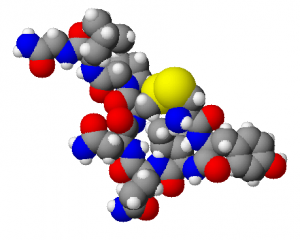Oxytocin has gotten a lot of hype as the biological basis of our favorite human emotion, Love. Oxytocin is a hormone produced by the hypothalamus and released by the posterior pituitary gland. The oxytocin system is involved in HPA axis and autonomic nervous system functions as well as reproductive functions and social behaviors. We are coming to understand how the structure of the the receptor for the hormone oxytocin influences oxytocin’s effects and social behavior, including love.
In order to have an impact on our bodies’ functions, hormones must attach to receptors inside our cells or on cell surfaces. When hormones bind to these receptors, that can lead to changes in the cell. The actions of oxytocin are all mediated by one type of oxytocin receptor in our brains and our bodies. These receptors are integral to cell membranes and activate cellular responses in response to sensing oxytocin outside of the cell. In the brain, oxytocin receptors are present in areas involved in reproductive and maternal behaviors and learning, memory, and reinforcement including the ventromedial nucleus, the amygdala, the hypothalamus, the lateral septum, the bed nucleus of the stria terminalis, the preoptic and ventral tegmental areas, and the hippocampus (Viero et al., 2010).
The gene that codes for the oxytocin receptor is present in a single copy in the human genome, on chromosome 3! Single nucleotide polymorphisms are variations in DNA sequences in which a single nucleotide differs. (Remember your high school biology? Nucleotides are the building blocks of our DNA. The nucleotides in DNA are cytosine, C, thymine, T, adenine, A, and guanine, G.) Many single nucleotide polymorphisms have been identified in humans in the gene that codes for the oxytocin receptor. Researchers have investigated differences in peoples’ biological and psychosocial parameters associated with variations in the DNA sequence that codes for the oxytocin receptor.
The most researched single nucleotide polymorphism is called OXTR SNP rs53576. The paired nucleotides at that location have been found to vary between AA, AG, and GG. This single nucleotide polymorphism has been related to emotions and psychological resources, prosocial behaviors including parental responding, anxiety and depression, and stress reactivity. In general, having AA or GA nucleotides at this location [in contrast to having GG nucleotides] appears to be associated with greater risk and poorer profiles of prosocial traits and behaviors like having the psychological resources optimism, mastery, self-esteem (Saphire-Bernstein et al., 2011) and being sensitive to children (Bakermans-Kranenburg & van Ijzendoorn, 2008; Riem et al., 2011).
Research has linked single nucleotide polymorphisms at other locations on the oxytocin receptor gene to
other prosocial constructs including parenting behavior, attachment, empathy, trust, and autism behaviors as well as anxiety and depression, and reactivity to stress reactivity. This work suggests that the oxytocin receptor gene and the oxytocin system are integral to psychosocial functioning. Researchers are still working to better understand the ways the system has its effects on human behavior. Stay tuned!
References and Further Reading
Bakermans-Kranenburg, M. J., & Van Ijzendoorn, M. H. (2008). Oxytocin receptor (OXTR) and serotonin transporter (5-HTT) genes associated with observed parenting. Social Cognitive and Affective Neuroscience, 3(2), 128–34.
Lee, H. J., Macbeth, A. H., Pagani, J. H., & Young, W. S. (2009). Oxytocin: the great facilitator of life. Progress in Neurobiology, 88(2), 127–51.
Riem, M. M. E., Pieper, S., Out, D., Bakermans-Kranenburg, M. J., & van Ijzendoorn, M. H. (2011). Oxytocin receptor gene and depressive symptoms associated with physiological reactivity to infant crying. Social Cognitive and Affective Neuroscience, 6(3), 294–300.
Saphire-Bernstein, S., Way, B. M., Kim, H. S., Sherman, D. K., & Taylor, S. E. (2011). Oxytocin receptor gene (OXTR) is related to psychological resources. Proceedings of the National Academy of Sciences, 108(37), 15118-15122.
Viero, C., Shibuya, I., Kitamura, N., Verkhratsky, A., Fujihara, H., Katoh, A., Ueta, Y., et al. (2010). Oxytocin: Crossing the bridge between basic science and pharmacotherapy. CNS Neuroscience & Therapeutics, 16(5), e138–56.
